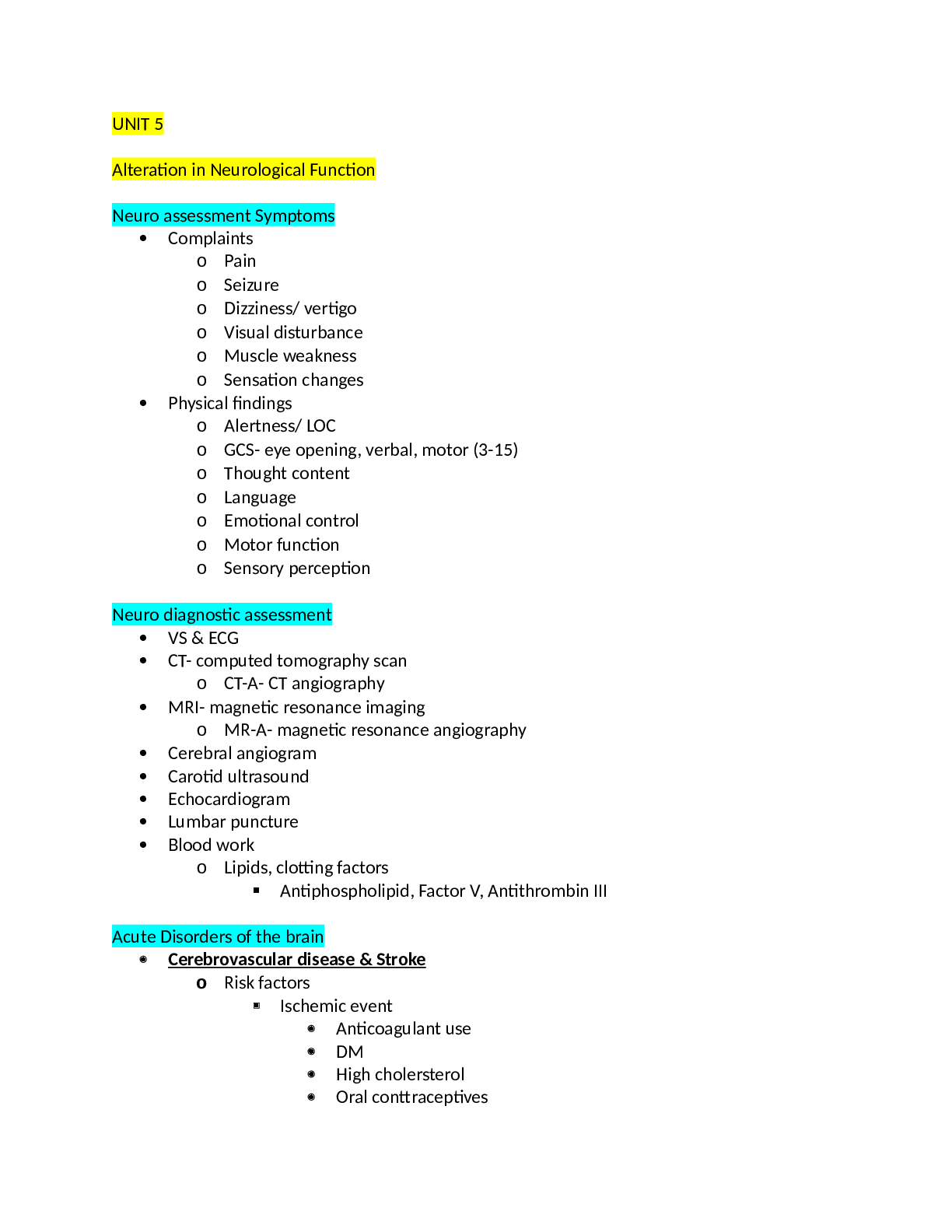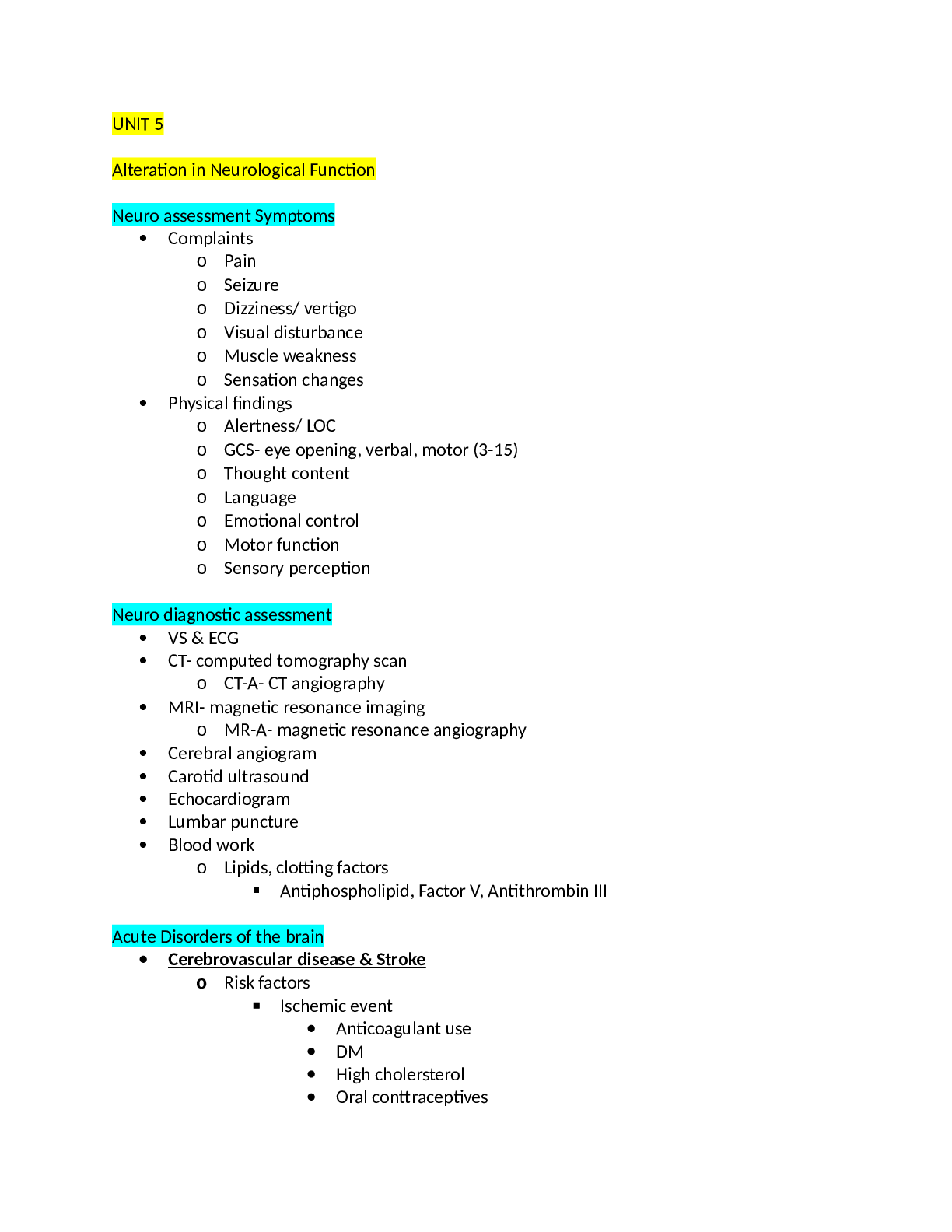Alteration in Neurological Function
Neuro assessment Symptoms
Complaints
o Pain
o Seizure
o Dizziness/ vertigo
o Visual disturbance
o Muscle weakness
o Sensation changes
Physical findings
o Alertness/ LOC
o GCS- eye opening, verbal, motor (3-15)
o Thought content
o Language
o Emotional control
o Motor function
o Sensory perception
Neuro diagnostic assessment
VS & ECG
CT- computed tomography scan
o CT-A- CT angiography
MRI- magnetic resonance imaging
o MR-A- magnetic resonance angiography
Cerebral angiogram
Carotid ultrasound
Echocardiogram
Lumbar puncture
Blood work
o Lipids, clotting factors
Antiphospholipid, Factor V, Antithrombin III
Acute Disorders of the brain
Cerebrovascular disease & Stroke
o Risk factors
Ischemic event
Anticoagulant use
DM
High cholersterol
Oral conttraceptives
Carotid artery disease
Physical inactivity
Obesity
Afib
Smoking
Stress
Hemorrhagic event
Hypertension
Anticoagulation therapy
Obesity
Excess alcohol intake/ drug use
Stress
Trauma
o Stroke (CVA)/ TIA findings
Acute/ unilateral
Lethargic
Obtunded
Numbness
Weakness/ hemiparesis
Paralysis/ hemiplegia
Hemianopsia- loss of half of vision field
Agnosia- inability to recognize objects
Dysarthria- difficulty forming words
Apraxia- inability to perform familiar tasks
Ataxia- unsteady gait
Neglect
Aphasia
Expressive
Receptive
Global
Emotional change
Behavioral change
Cognitive change
o TIA/RIND
Presents as stroke
Neurological deficits
o Motor/sensory/visual
Neuro assessments
GCS/ symptoms
Symptoms resolve
1-2 hours
Ischemia, not infarct
Precursor to ischemic stroke
Diagnosis
Non-con CT
Carotid US, ECG, CT-A
Management
Assess (symptoms, full neuro, GCS)
Identify cause (BP, arteries, spasms)
Decrease risk
o Manage HTN/ cholesterol/ CAD
Patient education
Ischemia stroke vs. bleeding
Ischemic Stroke
o Blockage
o Thrombotic/ embolic
o Assessment/ nursing
GCS
FAST
NIHSS
o Diagnosis
Report any symptoms
LKW or LSN (last know well/ last seen normal)
Non-Con CT
30 minutes
Additional testing (MRI, MR-A, CT-A)
o Management
Assess/ stabilize*
tPA*- tissue plasminogen activator
page 2015 chart 67-3
screening/ inclusion/ exclusion (next slide)
3-4.5 hours of symptom onset
Within 60 minutes of arrival in ED
Weight based/ 1 min/ 60 min
Manage complications
Airway/ O2
Cardiac/ ECG
(later) immobility
o Bowel/ bladder
UTIs, incontinence, stool softeners (Dulcolax)
o TPA V. No TPA management
TPA
BP control (lower)
Bleeding consideration
Expectations
Very frequent VS/ assessment
No tPA/ >24 hours post tPA
Consider alternative medication therapies
o Antiplatelets (ASA, clopidogrel)
o Anticoagulants (warfarin, heparin, enoxaparin)
o Antihypertensives (MD choice)
o Statins (rosuvastatin, atorvastatin)
o Nursing interventions for ischemic stroke patient
NIHSS
Frequent neuro assessments, frequency depends on treatment
Swallow evaluation
TORBSST, Toronto bedside swallowing screening test
Monitor/ assess/ prevent complications
Exercise, turning, repositioning, mobility, self-care, bowel and
bladder, sexual dysfunction
Maintain medication administration regimen
Consult- nutrition, PT/OT, neurology
Monitor cardiac rhythm & vitals (BP, O2)
PRN oxygen therapy, BP controlled based on treatments
Patient and family education
Max functional status 6 months
o Nursing diagnosis
Impaired swallowing
Impaired speech
Ineffective health maintenance
Risk for impaired skin/ imbalanced nutrition: less than
Self-care deficit
Constipation
Impaired urinary elimination
Impaired comfort
Sexual dysfunction
Incontinence
Social- interrupted family process
Knowledge deficit
Risk for injury
Ineffective maintenance
Read More


